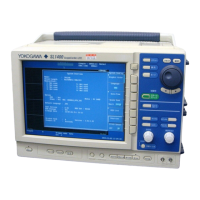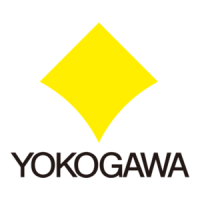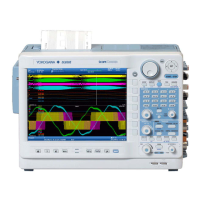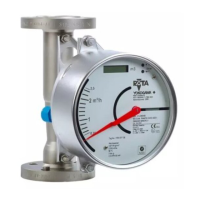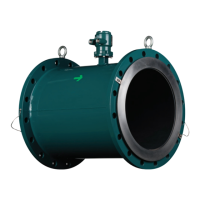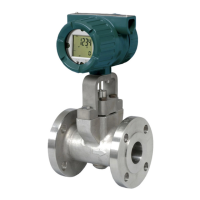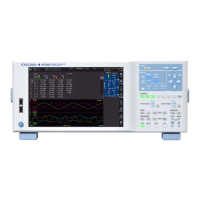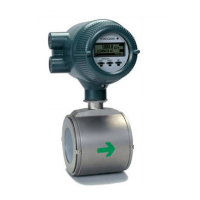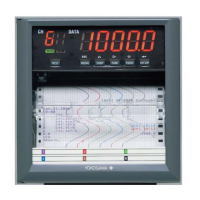
Do you have a question about the YOKOGAWA SR10000 series and is the answer not in the manual?
| Storage Temperature | -20 to 60 °C |
|---|---|
| Recording Media | external USB storage |
| Input Types | Thermocouple, RTD, Digital Input |
| Communication Interfaces | Ethernet, USB |
| Power Supply | 100 to 240 VAC, 50/60 Hz |
| Memory Capacity | Up to 32 GB (USB) |
| Isolation | Channel-to-channel isolation, channel-to-ground isolation |
| Operating Temperature | 0 to 40 °C |
Lists paper and electronic manuals available for the SR10000 Recorder.
Outlines the sections and chapters within the user's manual.
Details the recorder versions and functions covered by this manual.
Explains warning and caution symbols used throughout the manual.
Details how the recorder measures input signals and their ranges.
Explains how the recorder generates alarms based on measurement conditions.
Lists supported input types, their measurable ranges, and computation methods.
Describes scaling input values to appropriate units for measurement.
Explains calculating the square root of DC voltage input values.
Details function to indicate thermocouple burnout by off-scale recording.
Explains correcting measured values using segment linearizer approximation.
Discusses filter and moving average functions for noise suppression.
Explains using internal or external reference junction compensation.
Explains setting integration time to suppress power supply frequency noise.
Lists and defines the available alarm types (H, L, h, l).
Details how to specify alarm values for different input types.
Explains the recorder's capability to record measured values and other data.
Details recording measured values with pens or dots on chart paper.
Details selectable chart speeds for pen and dot models.
Describes expanding a section of the recording range for detailed view.
Explains compensating for pen offsets along the time axis.
Explains how the recorder prints out data and settings.
Explains time ticks indicating date/time positions on chart paper.
Explains printing channel numbers or tags on the dot model chart.
Explains printing measured values and data at determined intervals.
Lists and describes the data included in periodic printouts.
Explains printing alarm occurrence and release information.
Explains printing preset messages on the chart paper.
Details selectable formats for printing and displaying the date.
Details selectable formats for printing the time.
Explains printing list or setup lists of recorder settings.
Explains printouts at recording start and stop with messages.
Details setting options for start and end printouts.
Explains operations controlled via remote signals to input terminals.
Lists functions that can be assigned to remote control input terminals.
Covers additional functions like Key Lock and Customize Menu.
Explains prohibiting key operations and releasing with a password.
Explains settings for various recorder functions and refers to relevant sections.
Explains how to set the input range for each measurement channel.
Explains how to set alarms for each measurement channel.
Explains assigning units to channels with scaled inputs.
Explains how to change the chart speed for recording.
Explains how to set the recorder's date and time.
Explains setting the dot printing interval for trend recording.
Explains setting the filter function and its time constant for pen models.
Explains setting the moving average function and number of samples.
Explains setting recording zones to improve readability of overlapping data.
Explains enabling and setting the partial expanded recording function.
Explains assigning tags (labels) to measurement channels.
Explains setting custom message strings for printing.
Explains correcting scaled values using segments for improved accuracy.
Explains setting start/end printouts and batch numbers for recording.
Explains setting diagnosis output, relay operation, and alarm hysteresis.
Explains setting the action for detected burnout on thermocouple or 1-5V inputs.
Explains selecting printout items and turning them on/off.
Explains selecting printout options for alarm occurrence/release.
Explains setting the periodic printout interval mode and reference time.
Explains setting which keys are locked and setting a password.
Explains enabling or disabling the moving average function for dot models.
Explains enabling/disabling bias, low-cut, and calibration correction functions.
Explains how to initialize recorder settings to their factory defaults.
Explains assigning functions to specific remote control input terminals.
Lists error codes, messages, and their explanations or countermeasures.
Provides flow charts for diagnosing and correcting common operational problems.
Outlines periodic checks to maintain the recorder in good working order.
Provides instructions for cleaning the recorder's parts.
Explains the process for calibrating the recorder to ensure measurement accuracy.
Lists the recommended instruments for performing recorder calibration.
Explains how to adjust pen positions for accurate recording.
Explains adjusting hysteresis, zero, and full positions for dot printing.
Details input types, ranges, scan intervals, and measurement accuracy.
Details number of alarms, alarm types, hysteresis, and display.
Details specifications for trend recording, chart paper, and zone recording.
Details printing width, type, length, and feeding accuracy of chart paper.
Details display specifications, screens, and displayed contents.
Details specifications for optional functions like alarm relays and communication interfaces.
Details construction, operating conditions, and power supply specifications.
Lists ambient temperature, humidity, and power supply conditions.
